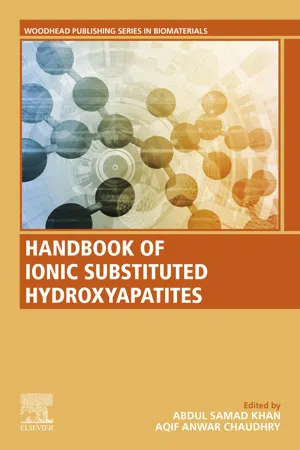
Handbook of Ionic Substituted Hydroxyapatites
Abdul Samad Khan,Aqif Anwar Chaudhry
- 428 Seiten
- English
- ePUB (handyfreundlich)
- Über iOS und Android verfügbar
Handbook of Ionic Substituted Hydroxyapatites
Abdul Samad Khan,Aqif Anwar Chaudhry
Über dieses Buch
Handbook of Ionic Substituted Hydroxyapatites provides scientists and researchers with comprehensive information on the synthesis processes of hydroxyapatite, also explaining the application of substituted hydroxyapatite. The book's content is very structured and explanatory, starting with a detailed overview of biological apatite in bones and teeth, as well as a presentation of the analytical tools for hydroxyapatite. Bioceramics and the relative modern and emerging processing techniques are covered, as is 3-D printing, which has gained increasing importance within biomedical materials and in the use of hydroxyapatite in tissue engineering. Finally, the advantages and disadvantages of using ionic substitutions in clinical application are presented.
Students and researchers in disciplines, such as Material Science, Ceramics, and Bioengineering will find this book to be very helpful in their work. It will also be a valuable resource for practitioners and surgeons in orthopedics, perio/implantology and maxillo-facial disciplines, and professionals working in R&D in ceramics and pharmaceuticals.
- Provides responses to the lack of scientific information about hydroxyapatites for biomedical applications
- Solves researchers' issues regarding phase changes with respect to substituted ions and how these substitutions can alter/improve the properties of stoichiometric hydroxyapatite
- Explains modern clinical applications and the effects of apatites within biomedical applications
- Includes both the advantages and disadvantages of using ionic substitutions in clinical application
Häufig gestellte Fragen
Information
Structure of biological apatite
bone and tooth
Abstract
Keywords
1.1. Introduction
| Crystallographic properties: lattice parameters (±0.0003 nm) | Enamel | Dentin |
|---|---|---|
| a-axis c-axis | 0.9441 0.6880 | 0.9421 0.6887 |
| Crystallinity index | 70–75 | 33–37 |
| Crystallite size (nm) | 0.13 × 0.03 | 0.0200 × 0.0040 |
| Ca/P molar | 1.63 | 1.61 |
| Components | Enamel % | Dentin % |
|---|---|---|
| Ca | 36.4 | 36.8 |
| P | 17.1 | 18.0 |
| CO | 3.4 | 6.55 |
| Na | 0.64 | 0.38 |
| Mg | 0.43 | 1.24 |
| F | 0.01 | 0.03 |
Inhaltsverzeichnis
- Cover image
- Title page
- Table of Contents
- Copyright
- Contributors
- About the editors
- 1. Structure of biological apatite: bone and tooth
- 2. Analytical tools for substituted hydroxyapatite
- 3. Bioceramics: types and clinical applications
- 4. Basics of hydroxyapatite—structure, synthesis, properties, and clinical applications
- 5. Role of substitution in bioceramics
- 6. Carbonate substituted hydroxyapatite
- 7. Fluoride-substituted hydroxyapatite
- 8. Magnesium-substituted hydroxyapatite
- 9. Zinc-substituted hydroxyapatite
- 10. Silver-substituted hydroxyapatite
- 11. Iron-substituted hydroxyapatite
- 12. Silicon-substituted hydroxyapatite
- 13. Effects of strontium substitution in synthetic apatites for biomedical applications
- 14. Coating of hydroxyapatite and substituted apatite on dental and orthopedic implants
- 15. Three-dimensional printing of hydroxyapatite
- 16. Hydroxyapatite and tissue engineering
- Index